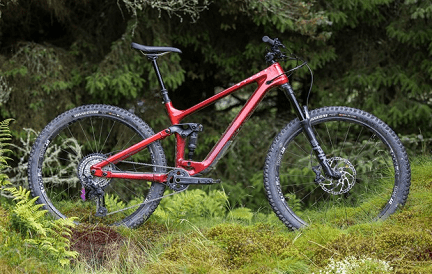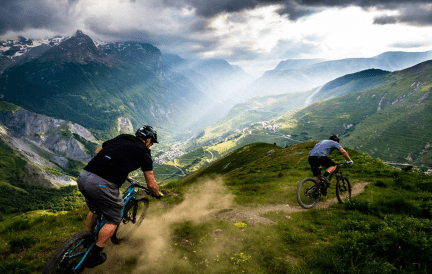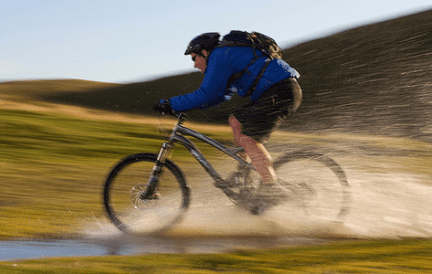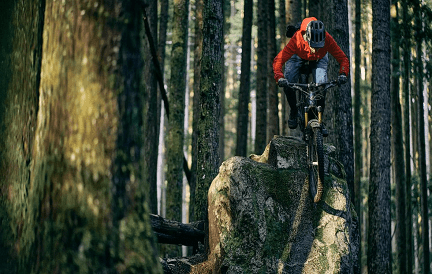Downhill cycle, like other cycles, have hydraulic disc brakes. They also have lower gear ratios to make mounting steep climbs and navigating obstacles easier. Here are some helpful hints to help you understand what you are getting yourself into.
- Part 1: Downhill Cycle
- Part 2: Categories of Downhill Downhill Cycle
- Part 3: Downhill Cycle Protective Gear
- Part 4: Essential Facts Mountain Bikers Should Know
Part 1: Downhill Cycle
Downhill cycle first gained popularity in the United States in the 1980s in California, when adrenaline junkies blasted down steep fire roads and dangerous illegal trails on their rickety short-travel cycles. The world of mountain biking has flourished, and now is an excellent moment to learn how to start . Professionally maintained flow trails, mountain bikes with modern geometry are all available today.
Downhill cycles are distinguished from conventional bikes by the addition of features targeted at strengthening durability and improving performance in tough terrain. Pedals range from simple platform pedals to clip-less pedals.

Most modern downhill cycle includes suspension, 26-inch, 27.5-inch, or 29-inch diameter tires with a width of 1.7 to 2.5 inches, and a broader, flat, or upwardly-rising handlebar that allows for a more upright riding stance and better control. They have a more compact, stronger frame, which is typically built of broad tubing. Tires on mountain bikes normally have a lot of treads and they are mounted on rims that are much stronger than those on non-mountain bikes.
Part 2: Categories of Downhill Cycle
Downhill cycles fall into two main categories: Full-suspension downhill mountain bikes and Hard tails.
Full-Suspension Downhill Mountain Bikes
Downhill cycles with full suspension include both a front fork and a rear shock to cushion bumps and bounces on the terrain. Without suspension, the ride would be extremely bumpy and rough, just like in a car. Full-suspension downhill mountain bikes’ front fork travel can range from 100mm for short-travel cross-country mountain bikes to 200+ mm for double-crown downhill (DH) bikes.
A short-travel full-suspension downhill cycle (100mm-130mm front fork travel) is good for cross-country cycling without many technical characteristics, but a mid-travel full-suspension mountain bike (130mm-160mm front fork travel) is better suited to the all-mountain or Enduro riding.
Full-suspension downhill mountain bikes offer a comfortable ride. They have ability to go down more challenging routes, and move to more difficult aspects. Full-suspension bikes have the disadvantages of not climbing as well as hardtails , being heavier, and being more expensive. These bikes cost nothing less than $5,000.
Hardtail Downhill Mountain Bikes
There is no rear shock on hardtail mountain bikes, only front fork suspension. If you intend on doing largely cross-country riding and want to put speed and accuracy above comfort in tough areas, they can be excellent trail bikes. The disadvantage is that if you wish to develop to more expert riding, hardtails are a little constrained. Fork travel ranges from 100mm to 130mm on most hardtail mountain bikes.
Hardtails have the advantages of being significantly lighter, more efficient (you don’t lose speed or momentum due to the rear shock), and less expensive. Hardtails have the disadvantage of being less smooth when riding over rocks, drops, and other technical elements, as well as having less travel and less fun. These bikes cost between $450 and $7,000.
Part 3: Downhill Mountain Bikes Protective Gear
Individual riders’ amount of protection varies widely, depending on speed, trail circumstances, weather, and a variety of other factors, including personal preference. When these elements are deemed to increase the likelihood or intensity of a crash, protection becomes more crucial.
For the majority of non-technical riding, a helmet and gloves are generally adequate. Downhill mountain biking typically employs full-face helmets, goggles, and armored suits or jackets, where the added mass and weight may assist lessen the risks of larger and more regular collisions.
A Helmet
Basically, there are three types and include:
- A half-lid helmet
- A full-face helmet
- A breakaway helmet
Half-Lid Helmet
A half-lid or ‘regular’ helmet is a good choice for most rides. These are suitable for daily rides with less challenging terrain or large features.
Full-Face Helmet
A full-face helmet will be your best friend if you simply want the most protection on the route. These are created to safeguard your head from all angles as well as the front of your face, including your dazzling whites. Full-face helmets have the disadvantage of being hot, so you won’t want to be wearing one too often.
Breakaway Helmet
Breakaway helmets give you the best of both worlds: you can use them as a ‘regular’ helmet for daily cross-country rides, and then add the chin bar to turn it into a full-face helmet for bike park terrain or rowdier trails. It is critical to purchase a MIPS-certified helmet or one with another safety certification (like SPIN). This mechanism works to protect your brain from not only direct but also rotational stresses.
Goggles or Glasses
When riding, wearing eye protection to protect your eyes from dirt, dust, and other flying debris is a smart idea. You can choose between sunglasses and goggles. At the start, any pair of sunglasses will suffice as long as they are polarized and visible in both full sun and shaded trail conditions. When riding at a bike park, many cyclists choose to use goggles instead of a full-face helmet because they are less likely to slip or fall off on bumpy terrain.
Knee Pads
If you ride frequently (or plan to ride frequently), knee protectors should be worn at all times. When it comes to knee pads, you have a few choices, just like with helmets:
- Soft knee pad sleeves are ideal for pedaling rides with little to no technology or high-stakes elements. The disadvantage of knee pad sleeves is that they frequently slip down when pedaling, which is extremely inconvenient.
- Hardshell knee pads: If you are going to the bike park or riding more tricky terrain, a pair of burlier knee pads that will protect you from sharper rocks and higher-speed accidents is an excellent idea. They’re usually heavier and sweatier, but if you fall, it is worth it.
- Coverage of the shins as well as the knees: for best safety, choose a knee pad that also protects the shins. There are a few choices available, but keep in mind that they are typically big, hot, and somewhat confining.
Elbow Pads
Elbow pads are not a must-have item of mountain bike safety equipment, but they can help avoid skinned elbows – or worse, a broken elbow or arm.
Padded Gloves
If you want to have more protection for your hands, some gloves come with hard or soft pads in strategic spots like the knuckles in case you unintentionally punch a tree. The 100% Geomatic gloves have a punk rock vibe to them. But the Fox Dirt paw gloves are not too cushioned but still provide extra protection in important areas.
Downhill Mountain Bike Pants
Downhill mountain bike pants do not generally give padded protection, but rather an extra layer of tough cloth to defend against scrapes and scratches. Knee pads will safeguard your legs from harder blows. The Fox Defend Pants, which are available in both men’s and women’s styles as well as youth sizes, are one of the most popular mountain bike pants options.
Most downhill mountain bikers ride in shorts , but if you plan to ride in cooler weather, in the rain and mud, or if you want to do a lot of downhill riding, durable and occasionally padded mountain bike pants may be the best option. Downhill mountain bike trousers have a slimmer cut at the ankles to avoid catching on your bike. But there is still enough room for knee pads underneath, and many offer sturdy protection for brutal downhill riding. Some mountain bike pants for cold weather riding have insulation as well.
Body Armor
Pads and body armor are designed to protect limbs and the body in the case of a collision. Body armor has trickled into other areas of mountain biking as trails have become steeper and more complicated. It was originally designed and marketed for downhill riders, free riders, and jump/street riders. Armor can range from basic neoprene coverings for the knees and elbows to complex; articulated hard plastic shells and padding that cover a complete limb or the full body.
Some firms sell body armor jackets and even full-body suits to offer better protection by providing more body covering and secure pad retention. Most upper-body protectors also include a spine shield, which is of plastic or plastic plates. BMX-style body armor, such as chest plates, abdominal guards, and spine plates, are also popular between certain mountain bikers.
Neck Brace
Downhill mountain bikers tend to wear a neck brace to protect themselves from whiplash or a broken neck in the worst-case situation. These straps keep the neck steady in the event of a collision, but they’re hefty and can be limiting. Only if you plan on riding at very high speeds or hitting big jumps and spending lots of time in the air, a neck brace may not be necessary.
First Aid Kits
Mountain cyclists frequently carry this to clean, dress, and splint broken limbs. As speeds increase, head, brain, and spinal injuries become more frequent. All of these can have a long-term impact on one’s quality of life. Downhill mountain bike guides with experience can deal with suspected spinal injuries.
Although protective equipment cannot always avoid injuries, it is essential to use it and keep it in good working order. Since mountain biking is outside, UV rays from the sun are present, and UV rays will destroy plastic components. Mountain bikers should replace bicycle helmet every five years or sooner if it appears outdated, as a general rule.
Part 4: These Essential Facts Mountain Bikers Should Know
When it comes to mountain biking, injuries are a primary concern, especially in the more severe sports like downhill biking. Cuts and abrasions can lead to significant injuries, such as head or spinal injuries. At the same time, delaying emergency response in the event of an injury in wildness is another problem.
Protective gear can help prevent minor injuries , but it may not be enough to protect a rider from significant collisions or mishaps. A rider will take steps to minimize the risk of injury by choosing trails within their skill level in order to handle the trail.
Finally, mountain biking requires more frequent upkeep of the rider’s bike than utility cycling or casual commuter biking. Mountain biking puts more strain on every component of the bike. Jumps and crashes can shatter the frame or damage components or tire rims. And fast descents can wear out brake pads prematurely. Brake pad wear, misalignment with, or slippage of rim brake pads on rims built for rim brakes or “V brakes” has been a non-issue since the widespread adoption of hydraulic and mechanical disk brakes on most mountain bikes in the late 1990s. Consequently, mountain biker inspects and maintains their bike before and after each ride.









